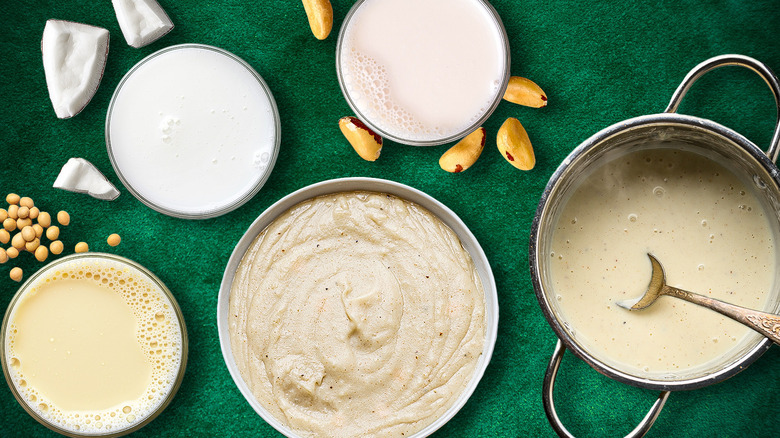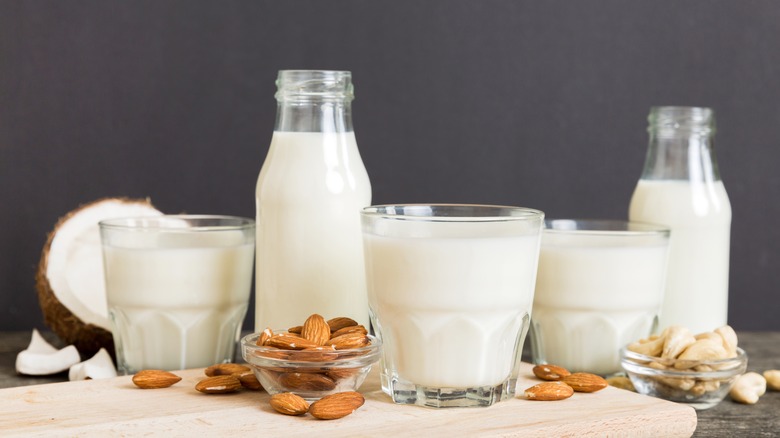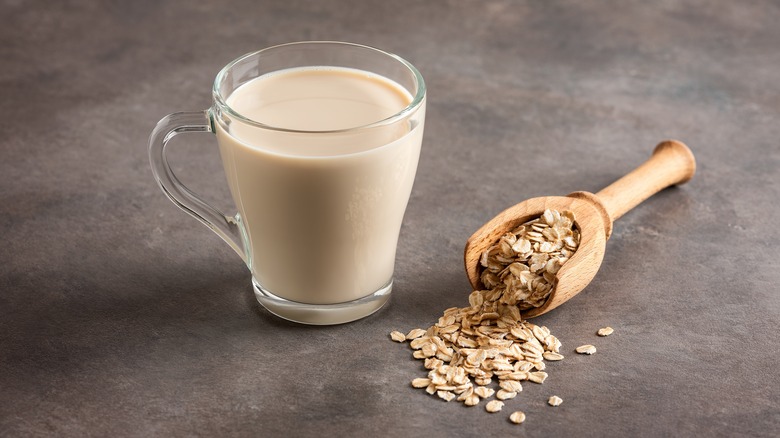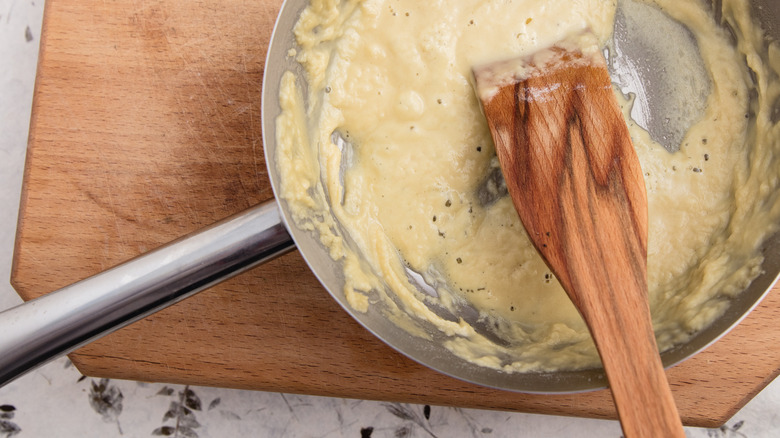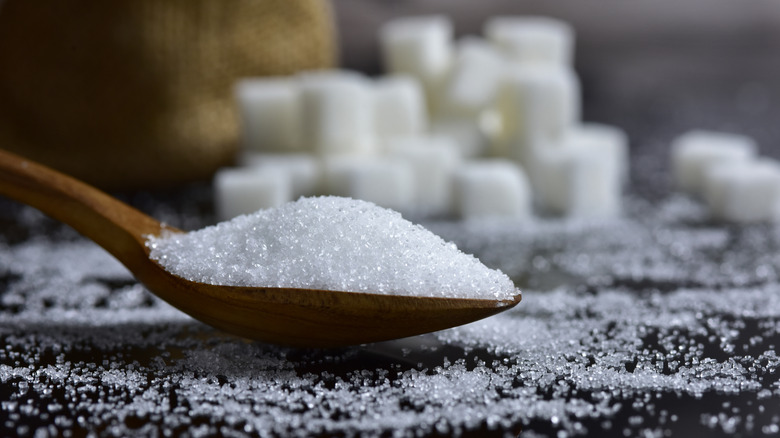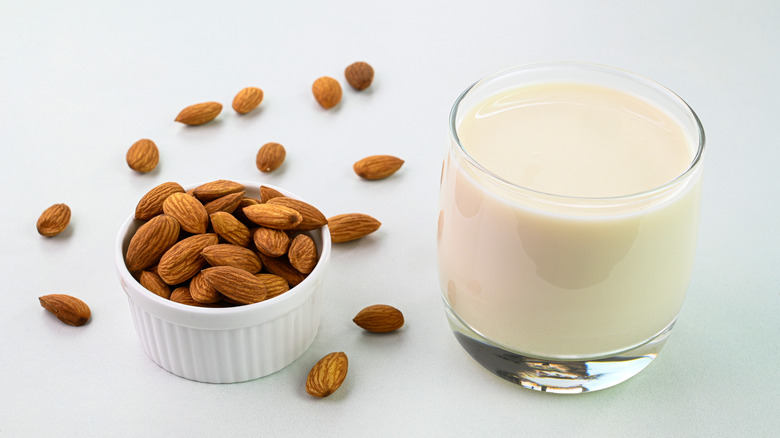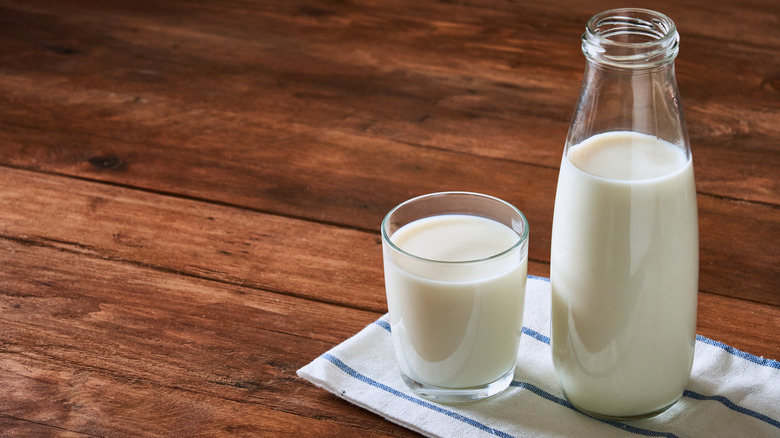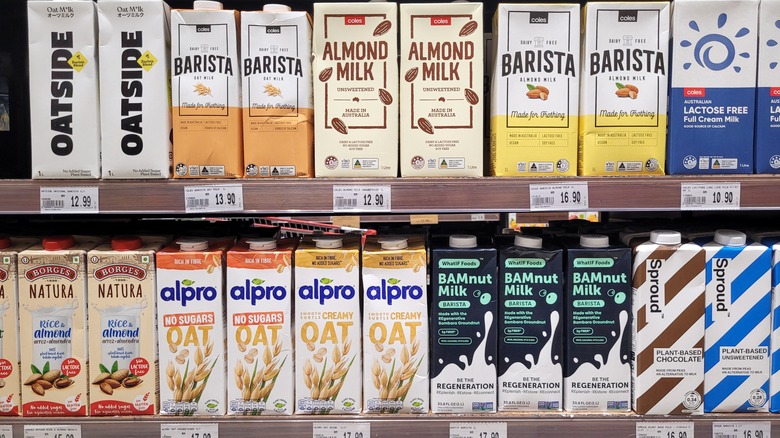10 Pro Tips For Using Plant-Based Milks In Sauces
We may receive a commission on purchases made from links.
Alongside the continuously rising popularity of plant-based diets comes the rising range and availability of plant-based milks. From firm favorites like oat and soy milk to unique options like sunflower seed milk, plant milk of various kinds can be found in an array of stores or made at home without much need for specialist equipment. As such, making plant-based sauces has never been easier, whether it be a recreation of traditional creamy dairy-based sauces or simply something wholly exclusive for a specific dish.
However, whilst the general means of creating a sauce using plant milk is fairly simple, there are certain things to keep in mind. As robust and versatile as most plant milks are, their suitability in a range of culinary applications does not mean that they act in the same way as dairy milk, and not making the appropriate adjustments can result in a less-than-ideal sauce.
For expert advice on how to get the best out of your plant milk for the perfect sauce, we spoke with Laura Wright, plant-based cookbook author and recipe developer behind The First Mess. Wright's valuable insight into cooking with plant-based milk provides you with everything you need to know, from selecting the right kind of milk to thickening and emulsifying it for a silky smooth consistency. So, whether you want to create a killer vegan mac and cheese or an indulgent dairy-free accompaniment for your dessert, here's everything you need to know about making sauces with plant milk.
Choose the right milk for specific sauces
When it comes to ensuring success using plant-based milks in sauces, selecting the right milk for the job gives you the best chance of success. There are many different kinds of plant milk with varying tastes, textures, and properties, and some are better suited for use in certain sauces than others. For example, nut milks with a slightly sweet taste will likely be better suited to sweet sauces like custard than slightly earthier, more savory alternatives such as pea milk or sunflower seed milk, which lend themselves well to pasta sauces and robust flavors.
For white sauces such as bechamel or alfredo, Laura Wright recommends using cashew, soy, or unsweetened oat milk. Thanks to their delicate taste and smooth consistency, these milks provide a neutral base that doesn't interfere with the sauce's overall flavor or overpower other ingredients — and this versatility also makes them suitable for use in sweet sauces. However, for a rich and indulgent dessert sauce, coconut milk should probably be your go-to. Wright notes that coconut is "a superstar in sweet recipes," lending its naturally thick and creamy texture to produce truly decadent results. Coconut milk also imparts its signature tropical, nutty, slightly floral taste on sauces it is incorporated into, which makes it a top choice if you're working with ingredients like chocolate, berries, or other tropical fruits like banana or pineapple.
Opt for homemade where possible
It's fairly unanimously agreed upon that homemade is almost always the way to go in the kitchen, and when it comes to making plant-based sauces, it's no different. Though it may seem like an unnecessary step, making and using your own plant-based milk will no doubt provide you with a fresher-tasting sauce, so it's worth taking the time where possible. Not only does homemade plant milk result in a creamier, more vibrant-tasting sauce, but it also ensures that you have complete control. Store-bought varieties of plant-based milks often contain stabilizers, preservatives, excessive sugar, and artificial flavorings, which are not only less than ideal if you're looking to cut back on processed foods, but can also interfere with a sauce's taste and texture.
Making your milk from scratch, however, means you can monitor your ingredients, adding as much or as little sweetener as desired and foregoing the unnecessary addition of artificial preservatives and flavors. Moreover, if you know what kind of texture you're aiming for with your sauce, you can adjust the consistency of your milk accordingly by altering the ratios of your ingredients, ensuring optimum flexibility.
Of course, making plant milk from scratch isn't always the most practical option, and there are occasions when grabbing a carton of the pre-prepared stuff is more feasible. Just try and opt for milks that contain minimal added ingredients, suggests Laura Wright, as this will put you in the best position for creating a sauce without any unwanted additives.
Thicken plant-based sauces with a roux or slurry
If you're looking to create a perfectly thickened and seriously smooth plant-based sauce, making a roux or slurry is your best bet. A classic technique in the culinary world for thickening sauces (and forming the base of sauces such as bechamel), making a roux is particularly useful in plant-based cooking since no dairy or eggs are required. Simply combine flour (all-purpose is a fail-safe option, but chickpea flour also lends itself well to thickening sauces) with a fat of your choice, such as olive oil or vegan butter, and add your milk, whisking as you go. It's a far better idea to make a roux than to attempt to add flour at a later stage, since flour added to hot liquids has a propensity to go clumpy, jeopardizing your entire sauce.
For those avoiding gluten, a slurry is an excellent alternative. "I recommend making your sauce to completion and then adding a slurry of cornstarch and a small portion of the liquid from the sauce near the end of the cooking process," says Laura Wright, adding that once you pour this into the mixture, you should keep stirring until the sauce thickens. If you need an alternative to cornstarch, arrowroot can also be used in the same way. Be wary, however, if you plan to chill leftover sauce since, as Wright points out, arrowroot does not perform as well upon reheating.
Pick plant milks that hold up to simmering
A lot of sauces require, at some point, boiling and simmering as part of their preparation, so it's important to choose a plant-based milk that can handle the heat without breaking down. The last thing you want, after combining all of your ingredients and nailing your flavor combinations, is for your milk to split and your sauce to separate, leaving it anything but smooth and silky, so it's no doubt worth checking that you're using milk that will maintain both its structure and taste during the cooking process.
On the whole, though, most plant-based milks fare well when used in sauces that are subject to high heat and are simmered for a while, and Laura Wright tells us that she has never had a sauce, soup, or stew made with plant milk curdle from being boiled too hard. However, she notes that it's probably best to avoid almond milk, which is the most likely to split. Other, less common types of plant milks, including potato milk and those made from seeds, may also be more susceptible to changes in texture or taste when cooked for long times at high temperatures, so it's worth experimenting with various types, perhaps in smaller batches of sauce first, to get to know their unique properties. You'll soon learn which milks hold their own the best when boiled or simmered and can thus select accordingly when it's time to prep.
Balance flavors by adding fat and sweeteners
As Laura Wright puts it, "When using plant milks to replace dairy, I think it's important to ensure that the plant milk you're using has a hint of sweetness and enough fat." Indeed, unlike dairy, which naturally contains both sugar and fat, plant-based milks often need a little help to reach that same balance and ensure perfect harmony. Fat no doubt plays an important role in creating satisfying and creamy sauces, as well as helping to distribute flavor, and so Wright recommends adding a little olive oil or vegan butter to plant milks that are naturally low in fat. Most nut milks, however, already contain a significant amount of hearty oils and natural fat, so you'll most likely not need to add additional sources to mimic the fatiness of dairy milk.
When it comes to sweetening things up, Wright often opts for maple syrup or cane sugar, but you can use whatever you like to add that subtle sweet undertone. White sugar will work just fine, but there is also an array of sweet alternatives with unique properties and textures that may also contribute extra depth and nuance to your sauce. Pick a sweetener that works best for your personal taste and recipe. Once again, you may find that certain milks are already sweet enough and don't require much alteration, so check both the sugar and fat content of your specific milk, and add sources of fat and sweetness in increments.
Avoid almond milk when working with heat
As Laura Wright established, almond milk is last on her list of plant-based milks you should use in sauces that will be boiled or simmered. As she explained, it's more prone to splitting when used at high temperatures, and it can also develop a bitter taste that may ruin a sauce entirely. If you keep a keen eye and ensure that the heat is moderate or low, you'll likely still have a successful sauce when working with almond milk, but once the sauce starts to boil, it's hard to salvage. Boiled almond milk is likely burnt, and the taste of burnt almonds is pretty hard to counterbalance, meaning you'll likely have to start entirely over again. Moreover, scorched almond milk can develop a strange texture, forming a skin on top of your sauce that is most likely not in line with the smooth and silky consistency you're probably after.
If you're set on using almond milk, be sure to keep the heat gentle and watch to make sure that the sauce does not boil. Methods like double boiling or microwaving in short increments are safer ways to heat up almond milk if you want to use it in a sauce, but heating it up separately can make it trickier to obtain a perfectly coherent sauce. As such, though almond milk lends itself incredibly well to a range of culinary applications, it's safest to opt for an alternative if your sauce requires boiling or simmering at any point.
Keep an eye on temperatures
Although not all plant-based milks are as susceptible to heat as almond milk, excessively high temperatures can be detrimental for a sauce made with plant-based milks regardless of what they are made from. Even more reliable options can still curdle or develop a strange taste if they are cooked for too long or with too intense heat. Different plant milks have different smoke points, which dictate how they handle heat and at what point things can start to look or taste a little off. Plant milks with higher levels of fat content may be more sensitive to heat than those that are predominantly water, for example, so be mindful of your milk's specific properties and adjust your heat according to what it can reasonably handle, which may entail a little bit of experimenting.
It's also useful to gently heat your plant milk before adding it to your sauce to reduce any risk of curdling. The temperatures of the two liquids being similar helps ensure a smooth emulsification process, for a perfectly smooth and harmonious sauce. If you've ever had your coffee or tea curdle upon adding nut milk, you'll no doubt be familiar with the textural issues that can occur from adding cold plant milk to hot liquid. It's generally good practice when working with plant milk to keep temperatures between liquids similar and consistent.
Gently reheat and whisk to fix a split sauce
While sauces made with plant milks are not inherently prone to splitting, Laura Wright notes that sauces that are frozen and then thawed can sometimes separate slightly. However, this separation in no way means that your sauce is ruined, and is very easily fixed. "I've always been able to fix this by gently reheating over the stove and whisking frequently," says Wright, so don't be dissuaded from freezing any leftover sauces out of fear they won't fare well under the cold conditions.
Finished dishes and thick sauces made with plant-based milks, like a coconut milk curry or a cashew milk-based vegan mac and cheese, can be frozen in airtight containers and gently reheated on the stovetop after thawing without much impact being made to their taste or consistency. Thinner sauces, or leftover homemade plant milks that can later be used for sauces, can be poured into ice cube trays and left in the freezer to set. Such a method may also make preparation easier in the future, especially if you're only looking for a single serving or a small portion of sauce.
Don't expect plant milks to act the same way as dairy products
Plant-based milks can no doubt be used to create rich, flavorful, and delightfully smooth sauces with unique tasting notes that arguably outshine more traditional dairy-based sauces. Nonetheless, it's important to remember that, despite this, plant-based milks do not act in the same way (and thus will not produce the exact same results) as cow's milk. Cow's milk has its own unique blend of fats, proteins, and sugars. As Laura Wright points out, "A lot of the plant milks are not as rich, so they don't 'cream up' a sauce as well as dairy milk," although she does add that cashew and coconut milk do tend to fare better in this regard than other plant milks. As such, you'll likely find that you need to adjust either your recipe or your expectations accordingly when making a sauce with plant-based milk that is conventionally made with dairy.
However, while creamy Alfredo sauce made with plant milk may not quite replicate the same rich mouthfeel that is granted by dairy milk, there are no doubt sauces that benefit from plant milk far more than cow's milk. Fragrant curries and spicy sauces, for example, gain a floral and earthy depth through the inclusion of coconut milk in a way that cannot be replicated with dairy, and oat milk can be used to create toasty and nutty sweet sauces that harmonize beautifully with desserts like warming crumbles and fruity pies.
Experiment with different kinds of plant-based milks
Tried and tested classics may offer a higher chance of success. If you're only just starting out, you may want to use recipes that are specifically designed for plant-based milks, keeping in mind that soy, oat, and cashew milk are some of the least temperamental options. However, as you familiarize yourself with the specific properties and tastes of different milks, you can begin to experiment. Testing out different kinds of plant-based milk for different types of sauces opens up a world of options, providing you the opportunity to truly elevate your cooking. You'll likely find that the array of plant milks available to you, whether homemade or store-bought, offer far more flexibility than traditional cow's milk.
Consider also going beyond more traditional plant milks. As Laura Wright points out, "Some of the unsweetened and unflavored non-dairy coffee creamers available now do a great job of enriching creamy sauces." Since coffee creamers are designed to be thick, smooth, and blend effortlessly into liquids, it comes as little surprise that they would work well as part of the base of a silky sauce, and yet they're quite likely to be overlooked when it comes to uses beyond diluting hot beverages. It's worth exercising a little creativity, keeping in mind that trial and error is all part of the process of creating perfect sauces.
